Veritech "Alpha" Fighter VF-6 (A,B,C,D,H,I,K,S,Z)
Veritech "Alpha" Electronic Attack VE-6 (A,B)
(Version 2.03 - Last updated:
02/16/04)
- Background and RPG stats by Kenneth
Olson
- Background Information
derived from Robotech.com
-
Robotech Research Picture archive for VF-6 "Alpha" Fighter (VF-6H,VF-6I,VF-6S,VF-6Z)
BACKGROUND
Beginnings
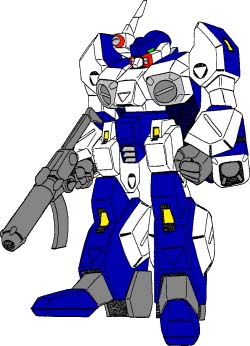 Perhaps
the greatest air-superiority mecha produced by the the Earth Defense Forces
during the three Robotech Wars, the VF-6 Alpha fighter spawned no less than 11
major variants and served continuously over thirty years. The VF-6 "Alpha"
project was born in 2012 as the VQ-6 "Vandal" designed to replace the
aging fleet of robotic QF-3000 "Ghost" fighters. Initial flight tests of
the Vandal showed that the unit was highly maneuverable in both atmospheric and
spaceborne operations. The initial testing went so well that the UEG
expressed interest in creating a third generation variable fighter out of the
Vandal airframe to replace the VF-4 "Lightning" as the primary air superiority
mecha for the newly formed Robotech Expeditionary forces.
Perhaps
the greatest air-superiority mecha produced by the the Earth Defense Forces
during the three Robotech Wars, the VF-6 Alpha fighter spawned no less than 11
major variants and served continuously over thirty years. The VF-6 "Alpha"
project was born in 2012 as the VQ-6 "Vandal" designed to replace the
aging fleet of robotic QF-3000 "Ghost" fighters. Initial flight tests of
the Vandal showed that the unit was highly maneuverable in both atmospheric and
spaceborne operations. The initial testing went so well that the UEG
expressed interest in creating a third generation variable fighter out of the
Vandal airframe to replace the VF-4 "Lightning" as the primary air superiority
mecha for the newly formed Robotech Expeditionary forces.
A preliminary engineering analysis of the VF-6 showed that the
Vandal airframe was capable of the necessary modifications to allow the
inclusion of transformation equipment and large number of internally mounted
missile systems and as a result production of seven experimental models began in
2017. All the experimental XVF-6 were completed in 2019, with the first
flight occurring at the RDF Folker Field on January 7, 2019. Except for the loss of a single fighter in
March 2019, the testing was so positive that the REF contracted for 2000 VF-6
fighters to be produced over the next three years ending with the launch of the
SDF-3 in December of 2022. Later in 2019, both the Robotech Defense Forces
and the newly created Armies of the Southern Cross ordered another 500 units
respectively.
VF-6A,-6B,-6C,-6D
Four variants were produced from 2019 until 2022. These
were the VF-6A, -6B, -6C, -6D. The VF-6A was the standard single seat air
superiority fighter. The VF-6B was designed for commanders similar in all
aspects to the -6A except for a more advanced combat computer capable of
interfacing with other VF-6A fighters and an advanced communications system.
The VF-6C was optimized for atmospheric operations. The standard P&W JG94
fusion turbines and 500 liters of internal D2O fuel was replaced with
P&W JG98. These engines give the VF-6C 300 kph higher speed in the
atmosphere, however, they are not nearly as fuel efficient in space possessing a
specific impulse of 4210 sec verses 4500 sec for the
JG94 and as result the -6C has only 50% of the delta-v for spaceborne
operations. The final variant was the two seat training model VF-6D
similar to the -6A variant.
All four of these initial variants were armored with the latest
second generation Choblam low-mass composite plating providing immunity from all
light anti-mecha weaponry and moderate protection from medium class (55mm or
less). However, repeated strikes from high power anti-mecha weaponry can
penetrate the armor and thus disable the unit. Unfortunately, the armor
also proved vulnerable to Invid physical attacks as the Choblam tended to break
off in large slabs. Although, subsequent generations of VF-6 fighters were
armored with more advanced composites which did not suffer the same
vulnerabilities early model VF-6 fighters were easily overwhelmed by Invid swarm
attacks.
The VF-6 primary armament was the internal MM-60 missile
launchers capable of firing up to 60 short range hammerhead missiles
in 3 seconds. This is a number equal to the maximum number of
short range missiles which a VF-1 "Valkyrie" could mount on four external
hardpoints. A secondary DD-6 medium range missile launcher is mounted
underneath each of the intakes carrying up to six diamondback missiles. In addition to the MM-60
and DD-6 systems, the VF-6 possesses a single hard
point on either wing capable of mounting two long , five medium, or fifteen
short range missiles apiece; however, the maximum atmospheric speed is reduced
by 200 kph when mounting external weaponry. Although a hand carried particle beam or
laser rifle was considered the technology at the time was not sufficiently
mature to produce a weapon small enough for the VF-6. Thus, the more
mature three barreled 35mm GU-13 was issued. Two RRG mk9 lasers capable of
firing 10 MJ bursts out to an effective combat range of 1500 meters were mounted
in the nose.
With the launching of the SDF-3 in December 2022, the REF took
2047 VF-6 fighters mostly of the -6A, and -6B models. A majority of the
-6C atmospheric models were left on earth to supplement the remaining RDF and
Tactical Air Forces in the Armies of the Southern Cross. These alpha
fighters on Earth would provide the bulk of the UEG defense through 2026
until large quantities were placed into reserve with the introduction of the
VF-8 Logan. By the start of the 2nd Robotech War all of the ASC VF-6
fighters were in reserve and only 100 units remained active in five RDF
squadrons. Combat casualties during the war decimated the
remaining VF-6 units on Earth; however, some 30 -6A,-6B, and -6C models survived
through the initial Invid invasion and formed the initial armored core of many
Earth resistance groups.
Meanwhile, the story of the VF-6 in the Robotech Expeditionary
Force took a dramatically different turn of events. Through the 2020's the
VF-6 "Alpha" formed the bulk of the air superiority forces on the Robotech
Expeditionary Force. Conventional spacecraft, such as the AF-1 Vulture and
AF-4 Volcano continued serve as the primary space superiority fighter whereas
the alpha fighters would be dropped from space to invade Invid held worlds.
Conventional craft, it was reasoned, could carry more fuel than a similarly sized variable fighter,
as the additional space taken by the transformation equipment could be used for
fuel instead. A battloid mode was not deemed as important for spaceborne
operations. After Tirol was recaptured in 2029, mecha production lines
were modified to produce VF-6A,-6B,-6C, and -6D models. A total of 5,387 VF-6
variants were produced from the Tirol mecha facilities from 2029 until 2035 at
which time production was switch over to the more modern VF-6H, -6I, and VE-6B
models.
VE-6A
The first two years of combat with the Invid, destroyed nearly
35% of all the VE-4G "Wild Weasels". This coupled with the fact that the
remaining VF-4's were nearly 20 years old made it clear to military planners
that a new electronic warfare platform was necessary. The first VE-6A was
produced from the newly refurbished mecha production lines on Tirol in 2032.
The VE-6A is based off the standard VF-6D two seat trainer;
however, the lower DD-6 missile launchers and shoulder hammerhead launchers are
replaced with electronic attack equipment. The VE-6A still retains
forty-four internal hammerhead short range missiles and can mount up to ten
medium range anti-radiation
missiles on the two hardpoints. The VF-6A mounts a powerful AM/AP-110 X-band
pulse Doppler radar on two electronically-scanned conformal antenna on either
side of the nose wheel bay. The AP-110 is capable of operating as
synthetic aperture radar which allows the system to paint a picture of ground
based units and provide target quality coordinates. The VE-6A mounts a AIL ALQ-100 on
board self-protection jammer mounted in the two shoulders providing broadband
protection and a Hughes USQ-150 communications jammer designed to detect,
analyze, monitor, and jam voice and data links. A total of 274 VE-6A were
built from 2032 to 2034 until replaced by the VE-6B in 2035.
VF-6K
After the liberation of Karbarra, thousands of eager Karbarran
warriors were made available to the Robotech Expeditionary Forces in addition to
newly reopened mecha and starship production lines. In order to take
advantage of this newly liberated resource, the REF high command extended permission to
the Karbarran Self Defense Forces to build a version of the VF-6 for their own
warriors. The VF-6K is, like the VE-6A, a derivative of the VF-6D two seat
trainer with the reinforced pilots compartment modified for the larger Karbarran frame. In all other aspects the VF-6K is virtually identical to
its other first generation variants -6A,-6B, and -6D models. A total of 23,154
units were produced from 2032 until 2040 when the VF-6K was replaced with
indigenous conventional designs. The Karbarran Self Defense Force
operated the remaining VF-6K well into the 2050's.
VF-6H,-6I,VE-6B
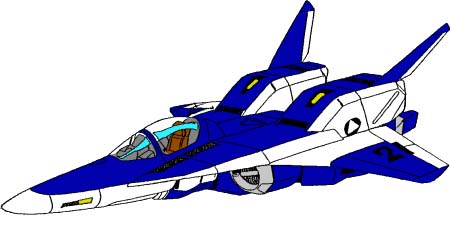 In 2035, the second generation of Alpha fighters were
introduced. These would be the primary models which would participate in
the Third Robotech War and endear themselves to the many Earth resistance groups
which operated the units during the years of occupation. The -6H,-6I, and
VE-6B models were specifically designed to replace the now decade old -6A, -6B,
and VE-6A models respectively. The newer models were now to take over spaceborne
combat operations from the conventional craft Although the second
generation models possessed greatly enhanced spaceborne capabilities and
delta-v, the addition of the VF-12 Beta fighter as a booster for these Alphas
allowed them to fight together in space, separate for atmospheric combat and
recombine to allow the Alpha to escape back into low orbit for rendezvous with
the carrier ships.
In 2035, the second generation of Alpha fighters were
introduced. These would be the primary models which would participate in
the Third Robotech War and endear themselves to the many Earth resistance groups
which operated the units during the years of occupation. The -6H,-6I, and
VE-6B models were specifically designed to replace the now decade old -6A, -6B,
and VE-6A models respectively. The newer models were now to take over spaceborne
combat operations from the conventional craft Although the second
generation models possessed greatly enhanced spaceborne capabilities and
delta-v, the addition of the VF-12 Beta fighter as a booster for these Alphas
allowed them to fight together in space, separate for atmospheric combat and
recombine to allow the Alpha to escape back into low orbit for rendezvous with
the carrier ships.
In all the models, the older P&W JG94 engines were replaced with
the P&W JG97M fusion turbines. The JG-97's could produce and additional 19
kN and 525 sec of specific impulse over the older models.
This increased the top speed of most second generation models 200 kph over their
earlier cousins in the
atmosphere and increased the spaceborne delta-v by nearly 100%.
The combat systems and sensors were considerably improved.
A third generation inertial combat system was included which improved the
responsiveness of all the units, allowing the pilots to perform combat maneuvers
unheard of in first generation models. A powerful AN/APG-95 X-band Doppler
radar capable of detecting 0 dBsm targets out to 200 km was added and this coupled with an
advanced IBM-210 combat computer gave the VF-6H and -6I mecha capabilities
similar to earlier long range early warning systems.
The armor and weapon systems were similarly upgraded. The
problematic Chobham plating of earlier models was replaced with a far more
resistance composite providing increased protection over the entire mecha.
All of the internal missile systems were retained. However, four GRL-4
mini-missile launchers were added on either side of the head for point defense
against Invid mecha which have closed into close range. The venerable
GU-13 was replaced with a EP-13 80mm particle beam cannon capable of firing 3.2 MJ pulses up to 550 times per minute.
The VE-6B armor, combat systems, and weapon systems were
similarly improved over the earlier VE-6A models. In addition the
electronic attack equipment was modernized. The older AP-110 model was
replaced with AM/AP-115 radar system providing 20% increase in detection range
while retaining all of the earlier multi-mode capability. The radar jammer was
similarly improved through the addition the ALQ-105 system providing broadband
protection with an estimated radiative power of 90 dBW, or 10 dBW better than
the ALQ-110 found on the VE-6A.
Production on the new models began in 2035 and continued well
into 2042 until they were replaced with the third generation VF-6S "Shadow
Alpha". A total of 31,754 VF-6I, 2,300 VF-6H and 743 VE-6B alpha
fighters were produced in the six years on mecha production lines on Tirol and
Karbarra.
VF-6Z
In 2037, the VF-6Z variant was introduced into the REF and was
designed to replaced the atmosphere-optimized VF-6C now almost twenty years old.
The VF-6Z made use of all the improvements found on the earlier second
generation Alpha variants -6H and -6I with the exception of using P&W JG99
atmospheric optimized fusion turbines instead of the standard JG97.
As with the -6C variant, spaceborne operations were sacrificed
for atmospheric performance as the -6Z model possesses higher top end speeds in
all modes and much greater atmospheric maneuverability over their standard -6H
and -6I cousins. This performance, however, came at the price of nearly
600 kg of D20 used as reaction mass. This coupled with the fact that for spaceborne
operations the specific impulse of the JG99 engines is almost 250 sec
less than the JG97 models results in short space legs for the -6Z, with a
delta-v of half that of -6H and -6I models.
Production began in 2037 and continued after the introduction of
the VF-6S because of the unique atmospheric combat capability which the -6Z
could fill. A total of 6,450 units were produced on mecha production lines
at Tirol.
VF-6S
The latest variant of the VF-6S was first produced in 2042 on
Tirol. The "Shadow" Alpha mounts a RRG MK2 Shadow device which is capable
of downshifting and adsorbing EM radiation, including emissions from
protoculture use. The protoculture emissions, and other EM radiation as
well, is therefore suppressed and downshifted so that they now appear out of
band from Invid protoculture sensors. In addition, the entire unit is
covered with a fourth generation radar absorbing material which is strongly
absorbs electro-magnetic radiation and thereby providing a passive system if the
RRG MK2 Shadow device should fail. A new low observable AN/APG-95C X-band
pulse Doppler radar was added to the unit. The system consists of six
conformal antenna on the nose, body, wings and tail thereby further reducing the
passive radar cross section.
The armor was improved with a fifth generation Chobham plate
providing an additional 10% in armor protection. The weapon systems were
largely retained, however, the ineffective GRL-4 mini-missile system was
removed. A EU-13 sub-nuclear destabilizer capable of firing 15 MJ pulses
was issued as the standard hand weapon. The system is powered from its own
dedicated protoculture canister and can fire up to 30 times per minute.
The particles have a specific, disrupting effect on force fields of all types
and will short out a lower power field completely, while high power fields, such
as Invid hive exterior shielding, will have a local failure.
Production for the new units was quickly ramped up in 2042 for
the planned invasion of earth in 2044. An initial production goal of
25,000 units over the two years was set to allow the inclusion of an all shadow
fighter force. This goal was reached with four months to spare with a
total production run of 30,121 units from 2042 through 2044.
RPG STATS
- Vehicle Type: VF-6 Alpha Fighter
- Class:
- VF-6A, -6I: Single seat, all-weather, aerospace air
superiority veritech fighter
- VF-6B, -6H: Single seat, all-weather, command aerospace air
superiority veritech fighter
- VF-6C,-6Z: Single seat, all-weather, atmosphere-optimized
aerospace air superiority veritech fighter
- VF-6D: Two seat, all-weather, trainer veritech fighter
- VF-6K, Karbarran single seat, all-weather, aerospace air
superiority veritech fighter
- VF-6S: Single seat, all weather, aerospace air superiority
veritech fighter with enhanced stealth capacities
- VE-6A, -6B: Two seat, all-weather, electronics warfare
veritech fighter
-
Manufacturer: Robotech Defense Forces, Armies of the Southern Cross, Robotech
Expeditionary Forces, and Karbarran Self Defense Forces.
Crew: One (or two) pilot(s) wearing Tactical Life Support System.
- Service History:
-
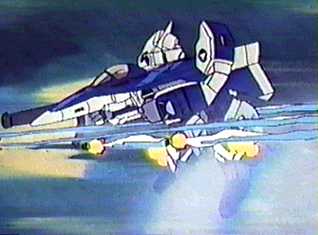 VF-6A: Served with the RDF Air Force, Navy, and Spacy from 2020
until the service disbanded in 2032. Served with the Southern Cross
Tactical Air Force and Navy from 2020 until they were replaced by the VF-8
"Logan" in 2028 and placed into reserve.. Served with the REF from 2020
until replaced with the -6I in 2032.
VF-6A: Served with the RDF Air Force, Navy, and Spacy from 2020
until the service disbanded in 2032. Served with the Southern Cross
Tactical Air Force and Navy from 2020 until they were replaced by the VF-8
"Logan" in 2028 and placed into reserve.. Served with the REF from 2020
until replaced with the -6I in 2032.
- VF-6B: Served with the RDF Air Force, Navy, and Spacy from
2020 until the service disbanded in 2032. Served with the Southern Cross
Tactical Air Force and Navy from 2020 until they were replaced by the VF-8
"Logan" in 2028 and placed into reserve.. Served with the REF from 2020
until replaced with the -6H in 2032.
- VF-6C: Served with the RDF Air Force, Navy, and Spacy from
2020 until the service disbanded in 2032. Served with the Southern Cross
Tactical Air Force and Navy from 2020 until they were replaced by the VF-8
"Logan" in 2028 and placed into reserve.. Served with the REF from 2020
until replaced with the -6Z in 2037.
- VF-6D: Served with the RDF Air Force, Navy, and Spacy from
2020 until the service disbanded in 2032. Served with the Southern Cross
Tactical Air Force and Navy from 2020 until all of the VF-6 series fighters
were placed in reserve. Served with the the REF continuously from 2020
onward with numerous upgrades to electronics and engines.
- VF-6H, -6I: Served with the Robotech Expeditionary Forces
from 2035 onward
- VF-6K: Built by the Karbarran self defense force under
contract by the REF. Production began in 2032 and continued into 2040.
- VF-6S: Served with the Robotech Expeditionary Forces from
2043 onward
- VF-6Z: Served with the Robotech Expeditionary Forces from
2037 onward
- VE-6A: Small numbers served with the RDF Air Force and Spacy
from 2030 until replaced by the VE-6B in 2035..
- VE-6B: Served with the REF from 2032 replacing the earlier
VE-6A models by 2035.
-
-
MDC BY LOCATION:
| Location |
VF-6 (A,B,C) |
VF-6 (D,K) |
VE-6A |
VF-6 (H,I,Z) |
VE-6B |
VF-6S |
| *Head |
50 |
50 |
50 |
50 |
50 |
50 |
| ** Head Sensor |
30 |
30 |
50 |
30 |
50 |
- |
| Hands (2) |
30 |
30 |
30 |
30 |
30 |
35 |
| Forearm / Missile Pods (2) |
40 |
40 |
40 |
100 |
100 |
125 |
| Shoulder / Missile Pods (2) |
60 |
60 |
60 |
80 |
80 |
100 |
| Upper Legs (2) |
100 |
100 |
100 |
100 |
100 |
110 |
| Lower Legs (2) |
100 |
100 |
100 |
125 |
125 |
135 |
| *** Main Body |
300 |
300 |
300 |
300 |
300 |
325 |
| Pilots Compartment |
150 |
175 |
175 |
175 |
200 |
200 |
| Wings (2) |
100 |
100 |
100 |
100 |
100 |
100 |
| Tails (2) |
50 |
50 |
50 |
50 |
50 |
50 |
| EU-13 / GU-13 |
75 |
75 |
75 |
75 |
75 |
75 |
| Destablizer |
100 |
100 |
100 |
100 |
100 |
100 |
NOTES:
- * Destroying the sensor head of the VF-6 will knock out the mecha's optical systems (infrared, nightvision, thermal). Radar and
communications will be unaffected.
- ** Destroying the sensor head of the VF-6 will knock out the secondary
radar and electronic protection systems.
- *** Depleting the MDC of the main body will destroy the mecha.
SPEEDS:
- RUNNING, SOLDIER CONFIGURATION:
- 100 kph for VF-6D and VE-6A,-6B
- 110 kph for VF-6A,-6B,-6C,-6K,-6S
- 120 kph for VF-6H,-6I,-6Z
- LEAPING, SOLDIER CONFIGURATION:
- 50 ft (15 m) high or 70 ft (21 m) long without thrusters.
- FLYING, SOLDIER CONFIGURATION:
- 300 kph for VF-6D
- 305 kph for VF-6K, VE-6A,-6B
- 310 kph for VF-6A,-6B,-6S
- 312 kph for VF-6,H,-6I
- 320 kph for VF-6C
- 340 kph for VF-6Z
- FLYING, GERWALK/SOLDIER CONFIGURATION:
- 650 kph for VF-6D
- 660 kph for VE-6A,-6B
- 670 kph for VF-6K,-6S
- 680 kph for VF-6H, -6I
- 700 kph for VF-6C
- 715 kph for VF-6Z
- FLYING, FIGHTER CONFIGURATION: At sea level / at 15 km
- 920 kph / 1820 kph for VF-6D
- 950 kph / 1840 kph for VE-6A,-6B
- 970 kph / 1850 kph for VF-6K
- 980 kph / 1880 kph for VF-6A,-6B
- 1050 kph / 2050 kph for VF-6S
- 1100 kph / 2070 kph for VF-6H,-6I
- 1150 kph / 2160 kph for VF-6C
- 1200 kph / 2300 kph for VB-6Z
- Stall speed : 182 kph (VTOL rectification possible)
Initial climb rate : over 20000m per minute
Service ceiling : 26 km (unboosted).
- DESIGNED G LIMITS:
- +12.0/-6.5 (Computer overrides at 9.5g)
- MAX ACCELERATION: SPACE
- 2.3g VE-6A
- 2.4g VF-6D,-6K
- 2.5g VF-6A,-6B
- 2.6g for VE-6B
- 2.7g for VF-6S
- 2.8g for VF-6C,-6H,-6I
- 3.0g for VF-6Z
- DELTA V:
- 1.1 kps VF-6C,-6D
- 1.4 kps VF-6Z
- 2.5 kps VF-6A,-6B,-6K
- 2.6 kps VE-6A
- 2.8 kps VF-6S
- 2.9 kps VF-6H.-6I,VE-6B
- Drop Tanks will provide an additional deltav of:
- 1300 liters - 3.2 kps
- 2310 liters - 5.5 kps
- 4000 liters - 9.0 kps
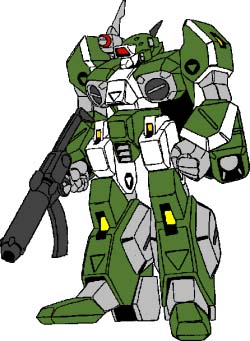 MAX ENGINE THRUST:
MAX ENGINE THRUST:
VF-6A,-6B,-6D,-6K, VE-6A
- 2 x Pratt & Whitney JG94 [Main]: Fusion
plasma-air/reaction turbines. Max thrust 118 kN each (specific
impulse of 4500 sec)..
- 4 x Turbo-Union ATF 380 [Auxiliary] : Miniaturized fusion plasma-air/reaction mass intermix
ramjets. Two are mounted on the upper rear (jet mode), and two as
VTOL thrusters on the lower fuselage. Each engine is rated to 43.1 kN standard thrust, max overboost to 86.2 kN each.
VF-6C
- 2 x Pratt & Whitney JG98 [Main] Fusion plasma-air/reaction mass intermix
turbines. Fusion plasma-air/reaction turbines. Max thrust,
140 kN each (specific impulse of 4210 sec).
- 4 x Turbo-Union ATF 390 [Auxiliary]: Miniaturized
fusion plasma-air/reaction mass intermix ramjets. Two are mounted on the
upper rear (jet mode), and two as VTOL thrusters on the lower fuselage. Each engine is rated to 45.0 kN standard thrust, max overboost to 90.0 kN each.
VF-6H,-6I,-6S, VE-6B
- 2 x Pratt & Whitney JG97M [Main]: Fusion
plasma-air/reaction turbines. Max thrust, 137 kN each (specific impulse of
5025 sec).
- 4 x Turbo-Union ATF 401 [Auxiliary]:.
Miniaturized fusion plasma-air/reaction mass intermix ramjets. Two are
mounted on the upper rear (jet mode), and two as VTOL thrusters on the lower
fuselage. Each engine is rated to 46.9 kN standard thrust, max overboost to 91.1 kN each.
VF-6Z
- 2 x Pratt & Whitney JG99 [Main]: Fusion
plasma-air/reaction turbines. Max thrust, 149 kN each (specific impulse of
4780 sec)..
- 4 x Turbo-Union ATF 410 [Auxiliary]:.
Miniaturized fusion plasma-air/reaction mass intermix ramjets. Two are
mounted on the upper rear (jet mode), and two as VTOL thrusters on the lower
fuselage. Each engine is rated to 51.3 kN standard thrust, max overboost to
102.6 kN each.
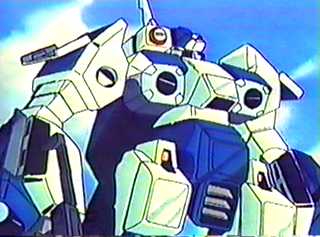 STATISTICAL DATA:
STATISTICAL DATA:
- SINGLE SEAT VERSIONS
- HEIGHT:
- 8.75m in soldier configuration.
- 5.72m in gerwalk configuration.
- 4.60m in fighter configuration.
- WIDTH:
- 4.84m at shoulders in soldier and gerwalk configuration.
- 8.20m with wings at maximum extension.
- LENGTH:
- 5.25m in soldier configuration.
- 8.00m in gerwalk configuration.
- 10.25m in fighter configuration.
- WEIGHT:
- 18,000 kg empty.
- TWO SEAT VERSIONS
- HEIGHT:
- 9.25m in soldier configuration.
- 6.0m in gerwalk configuration.
- 4.60m in fighter configuration.
- WIDTH:
- 4.84m at shoulders in soldier and gerwalk configuration.
- 8.20m with wings at maximum extension.
- LENGTH:
- 5.25m in soldier configuration.
- 8.5m in gerwalk configuration.
- 11.0m in fighter configuration.
- DRY WEIGHT:
- 16,700 kg VF-6H,-6I,-6Z
- 16,850 kg VF-6A,-6B,-6C
- 17,050 kg VF-6K
- 17,150 kg VF-6S
- 17600 kg VF-6D
- 18000 kg VE-6A
- 18200 kg VE-6B
- PHYSICAL STRENGTH:
- Equal to a P.S. of 60
- CARGO:
- Small compartment behind pilot's seat for personal belongings in addition to the cyclone
storage compartment
- POWER PLANT:
- VF-6A,-6B,-6C,-6D,-6K: 2 x RRL-2P Miniaturized Protoculture-cell energizer
each providing a total 700 MW of power
- VF-6H,-6I,-6Z,VE-6A: 2xRRL-3 miniaturized protoculture-cell
energizers each providing a total of 800 MW of power.
- VF-6S,VE-6B: 2xRRX-3 miniaturized protoculture-cell energizers each
providing a total of 870 MW of power.
- FUEL CAPACITY:
- All: 16 standard canisters of Protoculture
Optional:
1 dedicated canister for each EP-13/EU-13 gun pod
- VF-6C,-6D: 450 liters of D20 for reaction mass
- VF-6Z: 500 liters of D20 for reaction mass
- VF-6A,-6B,-6H,-6I,-6S: 1000 liters of D20 for reaction
mass
- VE-6A,-6B: 1100 liters of D20 for reaction mass
- COMPATIBLE FAST PACKS:
- NP-BP-22 FAST PACK Boosters
- TRans-EArth Deployment (TREAD) Booster
WEAPON SYSTEMS:
- GU-13 THREE-BARRELED 35MM GUN POD: firing 2000 rounds per minute, 600 round
capacity stored in the pod itself and in anon-detachable 'clip'. This weapon was
most common on the earlier models of the Alpha fighter from 2017 until it
was replaced by the widespread use of the EP-13 in 2035
- PRIMARY PURPOSE: Assault
- SECONDARY PURPOSE: Anti-Mecha
- RANGE: Armor Piercing Spin Stabilized Discarding Sabot Rounds (APSSDS) 5000 feet
(1500 m), High Explosive Armor Piercing, Standard, and Tracer 4000 ft (1200m)
- DAMAGE: APSSDS 3D6 short burst, 5D6 medium burst, 1D6*10 full melee burst.
HEAP 4D6 short burst, 1D6*10 medium burst, 2D6*10 full melee burst. Tracer rounds
reduce damage by 25%. Standard 4D6 short burst, 1D4*10 medium burst, or 2D4*10 full
melee burst
- RATE OF FIRE: Single shots or bursts equal to the combined attacks of the pilot.
- PAYLOAD: 40 short bursts, 20 medium, or 10 full melee. Two additional clips
are stored in the legs
- NOTES: APSSDS crits on 17,18,19,20. HEAP crits on 19,20.
Tracers add +2 to strike.
- EP-13 THREE-BARRELED 80MM PARTICLE GUN POD: Can fire 170 rounds per minute in
full automatic mode, also capable of firing all three barrels simultaneously in
semiautomatic mode at approximately one shot per second. This weapon fires 3.2 MJ
pulses per barrel with its own dedicated protoculture cell and capacitor banks in the
'clip'. This weapon, built into an external shell identical to that of the GU-13, was
developed in 2032 by the REF, but did not see wide use until 2035. By 2041,
the EP-13 had almost completely replaced the GU-13 as the main cannon of the Alphas in the REF's inventory.
- PRIMARY PURPOSE: Assault
- SECONDARY PURPOSE: Anti-Mecha
- RANGE: 1200 m
- DAMAGE: 2D4 for each Single blast, 1D6*10 for each triple blast, 2D4*10 for each
medium burst (up to six times per melee), or 4D4*10 for each full melee burst.
- RATE OF FIRE: Single shots or bursts equal to the combined attacks of the pilot.
- PAYLOAD: Conditionally unlimited. The protoculture cell is estimated to
have enough power for 3000 single shots, 1000 triple shots, 300 long bursts, or 100 full
melee bursts.
- EU-13 DESTABLIZER: sub-nuclear particle beam gun with output of 15 MJ, can fire
up to 30 times/minute. Draws power from its own dedicated protoculture canister, but
can be fired using the veritech's own power. Particles have specific, disrupting
effect on force fields, and will short out a low power field completely, while high power
fields may temporarily and locally cease to function.
- PRIMARY PURPOSE: Anti-force Field
- SECONDARY PURPOSE: Anti-Mecha
- RANGE: 4000 feet (1200 m)
- DAMAGE: 1D6*10 for each single shot
- RATE OF FIRE: Single shots equal to the combined attacks of the pilot up to eight
times per melee.
- PAYLOAD: Conditionally unlimited. Each protoculture cell can power up to
100 shots.
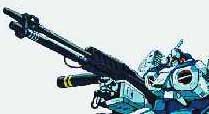
- (Optional) GA-15 40MM REF GAUSS RIFLE: See entry for GA-15
- PRIMARY PURPOSE: Assault
- SECONDARY PURPOSE: Anti-Mecha
- RANGE: 5.0 km
- DAMAGE: 2D4*10 for single shot
- RATE OF FIRE: The GA-15 fires up to 60 rounds per minute. The pilot can
fire as many single shots as his combined hand to hand attacks per melee
- PAYLOAD: 50 rounds stored internally.
- NOTES: -4 to strike within 500m

- RRG MK9 NOSE LASERS: Like the original VF-1 the Alpha fighter has two nose lasers
on either side of the pilot's compartment. The nose lasers may only be fired in
fighter mode
- PRIMARY PURPOSE: Assault/Defense
- SECONDARY PURPOSE: Anti-mecha
- RANGE: 1500 m
- DAMAGE: 1D4*10 for each single shot
- RATE OF FIRE: Equal to the combine attacks of the pilot
- PAYLOAD: Unlimited
- (All except VE-6A,VE-6B) MM-60 MULTI-MISSILE SYSTEM: The alpha fighter has 60 onboard
hammerhead short range missiles.
- PRIMARY PURPOSE: Assault/Defense
- SECONDARY PURPOSE: Anti-mecha
- RANGE: Varies
- DAMAGE: Varies
- RATE OF FIRE: One at a time or in volleys of two, four, eight, sixteen, thirty,
or all sixty eight
- PAYLOAD: 8 in each shoulder, 10 in each forearms, 12 in each lower leg
- (VE-6A,VE-6B) MM-44 MULTI-MISSILE SYSTEM: The two electronic
warfare versions of the VF-6 alpha have replaced the shoulder missiles with
additional electronic equipment. However, both the lower arm and leg
missile launchers are retained for self defense for a total of 44 hammerhead
short range missiles.
- PRIMARY PURPOSE: Assault/Defense
- SECONDARY PURPOSE: Anti-mecha
- RANGE: Varies
- DAMAGE: Varies
- RATE OF FIRE: One at a time or in volleys of two, four, eight, sixteen, thirty,
or all sixty eight
- PAYLOAD: 10 in each forearms and 12 in each lower leg
- (All except VE-6A,VE-6B) MM-16 MULTI-MISSILE SYSTEM: 16 hammerhead missiles can be stored in an optional
launcher between the two arms in fighter mode. Theses missiles must be fired before
the alpha fighter can transform
- PRIMARY PURPOSE: Assault/Defense
- SECONDARY PURPOSE: Anti-mecha
- RANGE: Varies
- DAMAGE: Varies
- RATE OF FIRE: One at a time or in volleys of two, four, eight, or all sixteen.
- PAYLOAD: 16 short range missiles
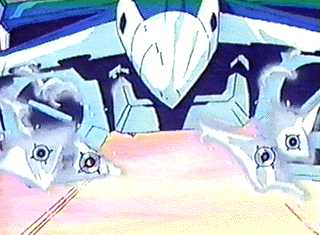
- (All except VE-6A,VE-6B) DDI-6 MEDIUM RANGE MISSILE SYSTEM: Six 260mm x 1.2m Diamondback
medium range missiles can be
stored under the intakes
- PRIMARY PURPOSE: Assault/Defense
- SECONDARY PURPOSE: Anti-mecha
- RANGE: Varies
- DAMAGE: Varies
- RATE OF FIRE: One at a time or in volleys of two, three, four or all six
- PAYLOAD: 3 in each intake for a total of 6
- NOTE: GM's may allow players to use any standard Palladium medium
range missile instead of Diamondback missiles.
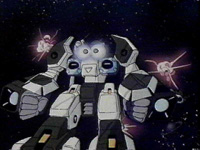
- (VF-6H,-6I,-6Z) 4 x GRL-4 MINI-MISSILE LAUNCHERS: Two missile launchers are mounted on
either side of the head (total of four launchers). Each launcher holds up to
four 76mm x 180mm Tarantula
LLLTV-and radar-guided missiles for a total of sixteen. Each tube can fire all of
their missiles in one volley. The Tarantula missiles use thermite warheads and have
a range of 1.1 km. These missiles are available only in battloid (in fighter and
guardian the launchers are covered up in the main body) and were used for close in defense
against incoming Invid scouts and shock troopers, although their effectiveness was
questionable.
- PRIMARY PURPOSE: Assault/Defense
- SECONDARY PURPOSE: Anti-mecha
- RANGE: 1.1 km
- DAMAGE: 3D6 MDC.
- RATE OF FIRE: One at a time or in volleys of 2, 3 or 4 per launcher
- PAYLOAD: Four missiles per launcher for a total of 16
- BODY/WING HARD POINTS: Two fixed hard points are mounted on each wing.
Each hard point can carry a missiles, fuel tanks (for spaceborne operations),
sensor or jamming pods (normally associated with VE-6A or -6B models).
Each hard point can carry up to 15 short range missiles, 5 medium range
missiles or 2
long range missiles or jamming.
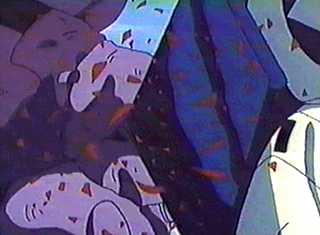
- HAND TO HAND COMBAT: If necessary, the Alpha can engage in melee combat rather
than use a weapon. The VF-6 is extremely agile and can execute most typical hand to
hand combat moves, such as punches, jump kicks, leap attacks, rolling with impacts, etc.
DAMAGE:
- Punch in Battloid: 3D6
- Punch in Guardian: 3D4
- Kick: 3D6
- Leap Kick: 6D6
- Body Flip/Throw: 3D6
- Body Block/Tackle: 3D6
- Stomp: 3D4. (only effective against small objects)
STANDARD EQUIPMENT FOR THE VF-6:
-
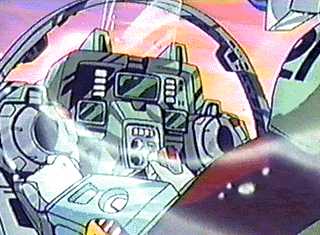 ACTIVE SENSOR JAMMER
WESTINGHOUSE ALQ-250(V): internal ECM providing broadband protection.
Estimated system effective radiative power 50 dBW.
ACTIVE SENSOR JAMMER
WESTINGHOUSE ALQ-250(V): internal ECM providing broadband protection.
Estimated system effective radiative power 50 dBW.
-
AUTO-PILOT: The VF-6 is equipped with a computerized auto-pilot, allowing the
pilot to relax or even sleep during long voyages. The auto- pilot can be programmed with a
single destination or a complex flight plan involving multiple speeds, directions, and
destinations. The onboard computer will alert the pilot when the fighter is near its
destination, and can also be set to automatically signal when sensors detect objects near
the mecha. The auto-pilot was designed with long intra-system space journeys in mind.
- (VF-6A,-6B,-6C,-6D,-6K,VE-6A) CHAFF AND FLARE DISPENSERS
AN/ALE-50: 24 chaff and 24 flares are stored in
each of the
lower legs
- (VF-6H,-6I,-6Z,-6S,VE-6B) CHAFF AND FLARE DISPENSERS
AN/ALE-55: 30 chaff and 30 flares are stored in
each of the
lower legs
- (VF-6A,-6B,-6C,-6D,-6K) COMBAT COMPUTER IBM-200:
The combat computer tracks and identifies specific enemy targets, and has a
database of over 1,000 images stored in memory. The computer can identify and
track up to 100 targets simultaneously.
- (VF-6H,-6I,-6Z,-6S)COMBAT COMPUTER
IBM-210: The combat computer tracks and identifies specific enemy targets,
and has a database of over 10,000 images stored in memory. The computer can
identify and track up to 250 targets simultaneously
- EXTERNAL AUDIO PICKUP: Range: 300 ft (91.5 m). A sound amplification system that
can pick up normal conversation up to 300 feet away.
- INFRA-RED WARNING RECEIVER OLDELFT (IRWR):
Providing rear aspect protection from IR guided missiles
- HEAT AND RADIATION SHIELDS: Special shielding prevents the penetration of life
threatening head and radiation. A radiation detection and alarm system are linked with the
shields and will sound an alarm if there is a rupture in the shields and what the levels
of radiation are.
- HOMING SIGNAL: The escape pod of the VF-6 is equipped with a homing
device that enables rescue teams to locate a disabled craft or ejected life pod. The range
of the signal is 400 miles (640 km). Most REF ships and veritechs can locate and track a
homing signal, and the onboard computers will automatically notify their pilots if such a
signal is detected.
- LASER TARGETING SYSTEM: Range: 100 miles (160 km). Used for increased accuracy in
the striking of enemy targets and is partly responsible for the mecha's strike bonus.
- LOUDSPEAKER: A loudspeaker system is built into the craft, which can be used to
amplify the pilot's voice up to 90 decibels.
- OPTICS (INFRARED): Range: 2000 feet (610 m). This optical system projects a beam
of infrared light that is invisible to the normal eye, but detectable by the mecha's
sensors. The system allows the pilot to detect hidden/concealed objects by their IR
reflectiveness. The beam will be visible to anyone with IR sensitive optics, however.
- OPTICS (NIGHTVISION): Range: 2000 feet (610 m). A passive light image intensifier
that emits no light of its own, but relies on ambient light which is electronically
amplified to produce a visible picture.
- OPTICS (THERMAL IMAGER): Range: 2000 feet (610 m). A passive optical heat sensor
that detects infrared radiation projected by warm objects and converts that data into a
false-color visible image. The system enables the pilot to see in the dark, in shadows,
and through smoke, and also adds a +10% bonus to pilots using a tracking skill.
- (VF-6A,-6B,-6C,-6D,-6K) RADAR AN/APG-90:
X-band pulse Doppler radar. Detection range
against 0 dBsm target 140 km. System consists of a single
electronically-scanned antenna mounted in the nose.
- (VF-6H,-6I,-6Z) RADAR AN/APG-95: X-band pulse Doppler radar. Detection range
against 0 dBsm target 200 km. System consists of a single
electronically-scanned antenna mounted in the nose.
- RADIO/VIDEO COMMUNICATION: Long range, directional communications system with
satellite relay capabilities. Range: 600 miles (960 km) or can be boosted indefinitely via
satellite relay.
- (VF-6A,-6B,-6C,-6D,-6K,VE-6A) RADAR WARNING RECEIVER
AN/ALR-80 (RWR): Providing all
aspect broadband protection from RF guided missiles.
- (VF-6H,-6I,-6Z,-6S,VE-6B) RADAR WARNING RECEIVER AN/ALR-80 (RWR): Providing all
aspect broadband protection from RF guided missiles.
- SELF-DESTRUCT: To prevent capture of an advance variable fighter by the enemy,
the pilot can activate the VF-6 self-destruct system, which will cause the fighter
to explode after a delay of up to 60 minutes (time is set by the pilot). The explosive
damage is contained within a 20 foot (6 m) area and inflicts 1D6x10 M.D. to everything
within the radius of the explosion. All internal systems are obliterated. The escape pod
will be automatically ejected prior to the explosion unless the pilot overrides the
ejection sequence.
- SMOKE DISPENSERS: Enough smoke is stored for 30
second of continuous coverage. After, 2040 smoke was formulated to cover
protoculture emissions, hence providing temporary protection for the alpha
fighter
- STANDARD SURVIVAL KIT: All REF veritechs come equipped with a portable survival
kit. Inside the small reinforced box is a medium-sized flashlight, two hand flares, one
rocket flare, a compass, infrared distancing binoculars, a small mirror, a pocket knife,
dehydrated and concentrated food (can be stretched into a five day supply for one person)
and basic first aid items (aspirin, bandages, disinfectants, etc.)
- TACTICAL LIFE SUPPORT SYSTEM: The VF-6 cockpit is pressurized, and also provides
additional air feeds to the pilot's flight suit that provides him with pressurized
breathing. The REF flight suit also contains an upper and lower g-suit that promotes blood
circulation even during high-g turns, thus decreasing the possibility of pilot's blacking
out in combat.
STANDARD EQUIPMENT FOR VE-6A
- RADAR: AM/AP-110 X-band pulse Doppler radar. Detection range
against 0 dBsm target 220 km. System consists of two
electronically-scanned conformal antenna on either side of the nose wheel bay.
AP-110 has 30 separate modes including the capability of operating as a
synthetic aperture radar which allows the system to paint a picture of ground
based targets to aid in targeting and thus enhancing weapon accuracy.
- RADAR JAMMER AIL ALQ-100: On board self-protection jammer
providing broadband protection. Estimated system effective radiative
power 80 dBW.
- COMMUNICATION JAMMER HUGHES USQ-150: Designed to detect,
analyze, monitor, and/or jam voice and data link signals powered by onboard
protoculture generators
STANDARD EQUIPMENT for VE-6B
- RADAR AM/AP-115: X-band pulse Doppler radar. Detection range
against 0 dBsm target 260 km. System consists of two
electronically-scanned conformal antenna on either side of the nose wheel bay.
AP-115 has 30 separate modes including the capability of operating as a
synthetic aperture radar which allows the system to paint a picture of ground
based targets to aid in targeting and thus enhancing weapon accuracy.
- RADAR JAMMER AIL ALQ-105: On board self-protection jammer
providing broadband protection. Estimated system effective radiative
power 90 dBW.
- COMMUNICATION JAMMER HUGHES USQ-150: Designed to detect,
analyze, monitor, and/or jam voice and data link signals powered by onboard
protoculture generators
STANDARD EQUIPMENT FOR THE VAF-6S:
- RADAR AN/APG-95C: X-band pulse Doppler
radar. Detection radar against 0 dBsm target 140 km. System
consists of six conformal antenna on the nose, body, wings, and tails, thereby
further reducing the passive radar cross section.
- RRG MK2 SHADOW: four-dimensional distortion field generator (downshifts
and dampens protoculture radiation) emitting only weakly in these wavebands.
NOTE: . Once the mecha has lost half of its main body MDC, there is a 50% chance that the
stealth system will fail every time the main body of the craft is hit. Once the stealth
system has failed, it will not work again until repaired at a RDF base.
- RRG MK4 EM-ABSORBING SKIN COVER: strongly absorbing EM radiation from
radio through ultra-violet wavelengths, and emitting only weakly in these bandwidths
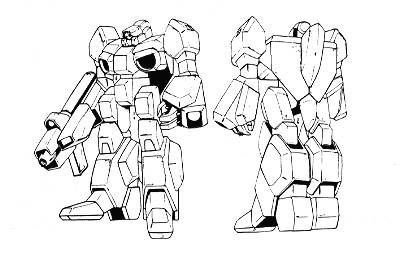
VF-6S "Shadow Fighter"
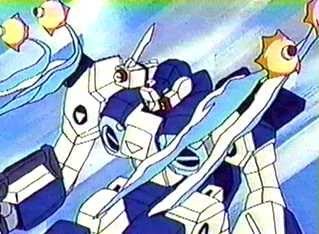 COMBAT BONUSES FOR VF-6A,-6B,-6C,-6D,-6K, VE-6A FIGHTER TRAINING:
COMBAT BONUSES FOR VF-6A,-6B,-6C,-6D,-6K, VE-6A FIGHTER TRAINING:
- 3 attacks per melee (plus those of the pilot).
- Add one additional action/attack at levels six and eleven.
- +2 to strike
- +2 to parry
- +3 to dodge in solder and guardian, +5 in jet mode.
- +3 to roll with a punch or fall with an impact, reducing damage by half.
- Critical strike same as pilot's hand-to-hand.
- Notes: -6C because of the ventral vertical stabilizer on the head
gives +3% on piloting skill checks in atmosphere and +3% on read sensory instruments
from
advanced stereoscopic imaging.
COMBAT BONUSES FOR VF-6H,-6I,-6Z,VE-6B FIGHTER TRAINING:
- 4 attacks per melee (plus those of the pilot).
- Add one additional action/attack at levels five and ten.
- +1 on initiative
- +3 to strike
- +3 to parry
- +3 to dodge in solder and guardian, +5 in jet mode.
- +3 to roll with a punch or fall with an impact, reducing damage by half.
- Critical strike same as pilot's hand-to-hand.
- Notes: -6Z because of the ventral vertical stabilizer on the head
gives +5% on piloting skill checks in atmosphere and +5% on read sensory instruments
from
advanced stereoscopic imaging.
COMBAT BONUSES FOR VF-6S FIGHTER TRAINING:
- 4 attacks per melee (plus those of the pilot).
- Add one additional action/attack at levels five and ten.
- +4 on initiative
- +3 to strike
- +3 to parry
- +3 to dodge in solder and guardian, +5 in jet mode.
- +3 to roll with a punch or fall with an impact, reducing damage by half.
- Critical strike same as pilot's hand-to-hand.
Random Hit Locations
When there is an equal chance of hitting both sides from 1D6
- 1-3 hits the right side
- 4-6 hits the left
When there is a preferred side, roll 1D10
- 1-8 hits the preferred side
- 9-10 hits the opposite side
| Alpha Fighter |
FRONT |
BACK |
SIDES |
TOP |
BOTTOM |
| Head (Main Body) |
01-03 |
- |
01-02 |
- |
01-04 |
| Sensor Head (Main
Body) |
- |
- |
- |
- |
- |
| Hands (Forearms) |
- |
01-03 |
- |
- |
- |
| Forearms (Shoulders) |
04-09 |
04-30 |
03-20 |
01-20 |
- |
| Shoulders (Main
Body) |
10-35 |
31-35 |
21-35 |
21-30 |
- |
| Upper Legs (Main
Body) |
36-45 |
36-40 |
36-45 |
- |
05-14 |
| Lower Legs (Upper
Legs) |
46-50 |
41-60 |
46-60 |
- |
15-34 |
| Wings (Main Body) |
51-55 |
61-65 |
61-65 |
31-55 |
35-59 |
| Tail (Main Body) |
56-60 |
66-70 |
66-75 |
56-59 |
- |
| Main Body |
61-70 |
71-85 |
76-80 |
60-75 |
60-75 |
| Pilot's Compartment |
71-95 |
86-95 |
81-95 |
76-00 |
76-95 |
| Gun Pod (Hands) |
96-00 |
96-00 |
96-00 |
- |
96-00 |
| Alpha Guardian |
FRONT |
BACK |
SIDES |
TOP |
BOTTOM |
| Head (Main Body) |
01 |
01-03 |
01-03 |
- |
01-05 |
| Sensor Head (Main
Body) |
02-06 |
04-09 |
04-09 |
01-07 |
- |
| Hands (Forearms) |
07-10 |
- |
10-13 |
08-09 |
06-09 |
| Forearms (Shoulders) |
11-19 |
10-25 |
14-30 |
10-19 |
10-25 |
| Shoulders (Main Body) |
20-26 |
26-35 |
31-40 |
20-29 |
26-35 |
| Upper Legs (Main Body) |
27-35 |
36-45 |
41-45 |
30-34 |
36-40 |
| Lower Legs (Upper
Legs) |
36-50 |
46-65 |
46-60 |
35-38 |
41-65 |
| Wings (Main Body) |
51-55 |
66-70 |
61-70 |
39-40 |
66-69 |
| Tail (Main Body) |
- |
- |
- |
- |
- |
| Main Body |
56-75 |
71-89 |
71-75 |
41-70 |
70-79 |
| Pilot's Compartment |
76-95 |
90-95 |
76-95 |
71-95 |
80-95 |
| Gun Pod (Hands) |
96-00 |
96-00 |
96-00 |
96-00 |
96-00 |
| Alpha Battloid |
FRONT |
BACK |
SIDES |
TOP |
BOTTOM |
| Head (Main Body) |
01-04 |
01-04 |
01-04 |
01-14 |
- |
| Sensor Head (Main
Body) |
05-08 |
05-08 |
05-08 |
15-25 |
- |
| Hands (Forearms) |
09-13 |
09-13 |
09-11 |
26-30 |
01-05 |
| Forearms (Shoulders) |
14-24 |
14-24 |
12-27 |
31-39 |
06-20 |
| Shoulders (Main Body) |
25-32 |
25-32 |
28-40 |
40-49 |
21-23 |
| Upper Legs (Main Body) |
33-40 |
33-40 |
41-45 |
- |
24-27 |
| Lower Legs (Upper
Legs) |
41-64 |
41-64 |
46-65 |
50-54 |
28-65 |
| Wings (Main Body) |
- |
65-75 |
66-67 |
55-57 |
66-69 |
| Tail (Main Body) |
- |
- |
- |
- |
- |
| Main Body |
65-92 |
76-85 |
68-83 |
58-91 |
70-84 |
| Pilot's Compartment |
93-94 |
86-96 |
84-94 |
92-95 |
85-91 |
| Gun Pod (Hands) |
95-00 |
97-00 |
95-00 |
96-00 |
92-00 |
REFERENCES USED IN THIS DESIGN
- Robotech.com: Veritech Alpha Fighter VF-6
- Robotech Technical Files: Veritech Alpha Fighter VF-6
- Palladium Books: "The Sentinels"
Back to Mecha Home
 Perhaps
the greatest air-superiority mecha produced by the the Earth Defense Forces
during the three Robotech Wars, the VF-6 Alpha fighter spawned no less than 11
major variants and served continuously over thirty years. The VF-6 "Alpha"
project was born in 2012 as the VQ-6 "Vandal" designed to replace the
aging fleet of robotic QF-3000 "Ghost" fighters. Initial flight tests of
the Vandal showed that the unit was highly maneuverable in both atmospheric and
spaceborne operations. The initial testing went so well that the UEG
expressed interest in creating a third generation variable fighter out of the
Vandal airframe to replace the VF-4 "Lightning" as the primary air superiority
mecha for the newly formed Robotech Expeditionary forces.
Perhaps
the greatest air-superiority mecha produced by the the Earth Defense Forces
during the three Robotech Wars, the VF-6 Alpha fighter spawned no less than 11
major variants and served continuously over thirty years. The VF-6 "Alpha"
project was born in 2012 as the VQ-6 "Vandal" designed to replace the
aging fleet of robotic QF-3000 "Ghost" fighters. Initial flight tests of
the Vandal showed that the unit was highly maneuverable in both atmospheric and
spaceborne operations. The initial testing went so well that the UEG
expressed interest in creating a third generation variable fighter out of the
Vandal airframe to replace the VF-4 "Lightning" as the primary air superiority
mecha for the newly formed Robotech Expeditionary forces.  In 2035, the second generation of Alpha fighters were
introduced. These would be the primary models which would participate in
the Third Robotech War and endear themselves to the many Earth resistance groups
which operated the units during the years of occupation. The -6H,-6I, and
VE-6B models were specifically designed to replace the now decade old -6A, -6B,
and VE-6A models respectively. The newer models were now to take over spaceborne
combat operations from the conventional craft Although the second
generation models possessed greatly enhanced spaceborne capabilities and
delta-v, the addition of the VF-12 Beta fighter as a booster for these Alphas
allowed them to fight together in space, separate for atmospheric combat and
recombine to allow the Alpha to escape back into low orbit for rendezvous with
the carrier ships.
In 2035, the second generation of Alpha fighters were
introduced. These would be the primary models which would participate in
the Third Robotech War and endear themselves to the many Earth resistance groups
which operated the units during the years of occupation. The -6H,-6I, and
VE-6B models were specifically designed to replace the now decade old -6A, -6B,
and VE-6A models respectively. The newer models were now to take over spaceborne
combat operations from the conventional craft Although the second
generation models possessed greatly enhanced spaceborne capabilities and
delta-v, the addition of the VF-12 Beta fighter as a booster for these Alphas
allowed them to fight together in space, separate for atmospheric combat and
recombine to allow the Alpha to escape back into low orbit for rendezvous with
the carrier ships. VF-6A: Served with the RDF Air Force, Navy, and Spacy from 2020
until the service disbanded in 2032. Served with the Southern Cross
Tactical Air Force and Navy from 2020 until they were replaced by the VF-8
"Logan" in 2028 and placed into reserve.. Served with the REF from 2020
until replaced with the -6I in 2032.
VF-6A: Served with the RDF Air Force, Navy, and Spacy from 2020
until the service disbanded in 2032. Served with the Southern Cross
Tactical Air Force and Navy from 2020 until they were replaced by the VF-8
"Logan" in 2028 and placed into reserve.. Served with the REF from 2020
until replaced with the -6I in 2032.  MAX ENGINE THRUST:
MAX ENGINE THRUST: STATISTICAL DATA:
STATISTICAL DATA:




 ACTIVE SENSOR JAMMER
WESTINGHOUSE ALQ-250(V): internal ECM providing broadband protection.
Estimated system effective radiative power 50 dBW.
ACTIVE SENSOR JAMMER
WESTINGHOUSE ALQ-250(V): internal ECM providing broadband protection.
Estimated system effective radiative power 50 dBW.
 COMBAT BONUSES FOR VF-6A,-6B,-6C,-6D,-6K, VE-6A FIGHTER TRAINING:
COMBAT BONUSES FOR VF-6A,-6B,-6C,-6D,-6K, VE-6A FIGHTER TRAINING: